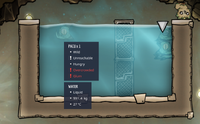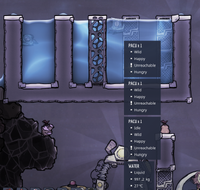Pacu
Pacu is an aquatic Critter found in pools in the Swamp Biome. They produce Pacu Fillets and Eggs, and their morphs can provide either fresh Water or decor bonuses. They can be domesticated.
Behavior
Pacu float around in liquids at the flooding level (over 35% of default mass), and will generally otherwise be in the "flopping" state; while flopping doesn't hurt them, it gives them confined status. They have a short lifespan of 25 cycles and a high egg mass (4kg). This makes them very useful for food and Lime. On death, they drop 1,000 kcal of Pacu Fillet, which can be cooked into 1,600 kcal of Cooked Seafood at an Electric Grill. Their excrement can be fed to Pokeshells for additional lime, although it takes about 22 to feed each.
Unlike most critters, which need to be groomed, Pacus are tamed by feeding from a Fish Feeder, and this takes much longer, about 10 cycles instead of the usual 2.
Their room size is calculated based on the amount of liquid tiles around them. Each Pacu requires 8 tiles each to not become crowded. Liquid inside and sectioned off by Mesh Tiles and Pneumatic Doors are counted and are treated as one homogeneous pool of liquid with the surrounding liquid. Unlike other critters, they will not be confined when inside an open door.
Pacus will only swim into tiles of at least 35% default mass, and have trouble swimming in different liquids. This can be used to limit Pacu movement for performance reasons or to help them reach their feed.
All Pacus have a mass of 200 kg when hatched and when they reach adulthood. Newly born Pacu have body temperatures which are specific to their variant, resulting in heat creation/deletion.
Variants
The Pacu is a temperature sensitive critter with two additional variants. Provided the fish is placed in a pool of the correct temperature, it produces its variants consistently and quickly. All maintain the same behavior, and large egg mass, making the difference largely a matter of preferred temperature, as Pacu's short lifespan and high masses will greatly stabilize an area's temperature.
Pacu
The classic pale green Pacu.
When Pacus hatch and reach adulthood, (which takes about 5.5 cycles,) their temperature is 30 °C.
Tropical Pacu
The colorful Tropical Pacu is the most frequently spotted variant morph of the Pacu. They emerge when a Pacu reproduces at a temperature above 35 °C. They provide a +25 decor out to a radius of 5 squares but this decor only penetrates Window Tile.
When Tropical Pacus hatch and reach adulthood, their temperature is 55 °C.
Gulp Fish
The blue Gulp Fish is the second variant of the Pacu. They emerge when a Pacu reproduces at a temperature below 5 °C. They also have the drawback of requiring temperature management - too hot and they die off, too cold and the pool they are in starts to freeze. They do, however, convert Polluted Water into Water, at a slow and consistent pace of 200 g/s. A large pool filled with these critters can produce enough fresh water to support a base though water needs to be siphoned off quickly thanks to its higher freezing point than Polluted Water. Alternatively, if the Polluted Water is cold enough the water that the Gulp Fish produces will instantly freeze into Ice, which can be collected and melted.
The water that Gulp Fish produce matches their internal body temperature, which can cause heat creation/deletion depending on a Gulp Fish's temperature relative to the Polluted Water that it takes in.
When Gulp Fish hatch and reach adulthood, their temperature is -12.5 °C.
Pacu Ranching
Tamed Pacu
A newly-born tame Pacu will live long enough to lay an egg, even when not fed, as long as it is not kept with too many other Pacu (8 in 8 tiles of liquid will work). This allows some limited starvation ranching potential, but the yield is rather low considering the investment in materials to set up systems to automatically store the starving Pacu and remove eggs. Alternatively, simply cooking a tame, fed Pacu's 13 spare eggs over its 25 cycle lifespan into [Omelette], at 5600 kcal each due to their large size, provides 2912 kcal per cycle average.
It is possible to sustain a single Pacu-breeder via Algae Distiller-Pufts pathway. One Pacu requires 7.5 kg of Algae per cycle. The 7.5 kg of Algae require 22.5 kg of slime per cycle, which can be covered with some excess by 1 tame Puft. This in turn would need 50 kg of Polluted Oxygen per cycle. Off-gassing such an amount from polluted water would require a surface area of around 188 tiles (Puft will require at least 144 tiles on their own to not get overcrowding effects). It can be supplemented by Polluted Oxygen Vents and Morbs, although Morbs' production rates are inconsistent. Pacu can also be fed Seeds, requiring 1 of any seed per cycle. Excess seeds from food crops or a Thimble Reed farm could be all you need to maintain a Pacu farm. The Pacu Feeder can only contain renewable seeds.
Farming is more feasible if you can find a way to heavily optimize the system and reduce the algae consumption. Otherwise it will rapidly deplete your algae reserves. With automation and by limiting the amount stored in the Fish Feeder it is possible to feed a single Pacu only a few kilograms of algae per cycle. The Pacu will eventually starve, but until around age 10 it will live of its internal energy store and continuously lay eggs. After that it will intermittently starve, but still have its reproduction increased for a short time directly after a feeding. The length of the starvation and with that the amount of additional eggs can be adjusted by choosing to feed it more algae. The number of produced eggs is thus less than if fed the maximum, but the far lower amount of algae used makes this an economical tradeoff.
An alternative option is to use seeds in your Fish Feeder, as these can be easily gained from a dedicated farm or just from the passive duplication in your colonies other farms. When making a dedicated farm for the Pacu. The Balm Lily can work well due to the lack of a fertilizer requirement and so only needs dupe labor to harvest. Sleet Wheat and Nosh Sprouts are effective alternatives due to their yields being large numbers of seeds. Arbor Trees and Bonbon Trees can provide seeds as well due to high drop chances on their many branches. Finally, Thimble Reeds are relatively fast to grow.
Wild Pacu
The Pacu's short lifespan and relatively large food output makes wild Pacu an easy source of food. Place them in a tank of any size; even a one tile pool will do. They will produce one egg throughout their life even when overcrowded and untamed, keeping their numbers stable, while dropping fillets for your Duplicants to eat when they die, with no resource costs.
Note that wild Pacu can still become Cramped if they are overcrowded when one lays an egg. This can be avoided by moving the egg into another room. A line of open Pneumatic Doors along the bottom of the pool can rectify this by causing freshly-laid eggs to drop out of the room.
Tips
- Wild, uncrowded Pacu will lay an egg when they are 20 cycles old. The parent can die just before the egg hatches.
- An adult, wild Pacu can be tamed in less than 8 cycles and taming from the egg takes under 12 cycles.
- Eggs retain the wildness of the parent at the time the egg is laid.
- Pacu Fry will only eat once from a Fish Feeder only containing Seeds.
History
- U50-581979: Happiness bonus from 'Recently ate from feeder' increased from +2 to +5, changed diet to 1 seed or 7.5kg algae per cycle, now only check surrounding liquid volume to determine if they are confined, now considered confined when flopping outside of sufficient liquid, had penalty for being crowded fixed to calculate correctly, and are no longer considered confined when positioned in open doors that are submerged in liquid.











